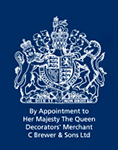Problem Solver - Alkaline
Problem
Normally excess mineral salts within the brick or masonry perculating to the surface if painted can cause extensive paint failure or salt deposits on the surface
Stages
Stage 1 - Preparation
Dry brush the surface down using a stiff bristle brush to remove any loose materials
If any mould or mildew is apparent, treat with a suitable fungicidal solution, rinse again with clean water and allow to dry.
If painted, check for cracks or areas of defective masonry and make good.
Stage 2 - Basecoat
Once the surface is clean and all chalk has been removed, treat with an Alkali Resisting Primer or suitable plaster primer and allow to dry.
Stage 3 - Topcoat
If bare, but intending to paint, if surface is sound apply a suitable emulsion paint to manufactures recommendations. Usually thinning the first coat, allowing to dry and then applying a second un-thinned coat.
Problem
Normally excess mineral salts within the brick or masonry perculating to the surface if painted can cause extensive paint failure or salt deposits on the surface
Stages
Stage 1 - Preparation
Dry brush the surface down using a stiff bristle brush to remove any loose materials
If any mould or mildew is apparent, treat with a suitable fungicidal solution, rinse again with clean water and allow to dry.
If being painted, check for cracks or areas of blown render where water could penetrate such as behind downpipes and gutters and make good.
Stage 2 - Basecoat
If bare brick, check the pointing and surface is sound, otherwise make good and if leaving bare, treat with a suitable silicone water protection.
Stage 3 - Topcoat
If being painted, apply a topcoat suitable to manufacturer’s recommendations and allow to dry – 2 coats.



